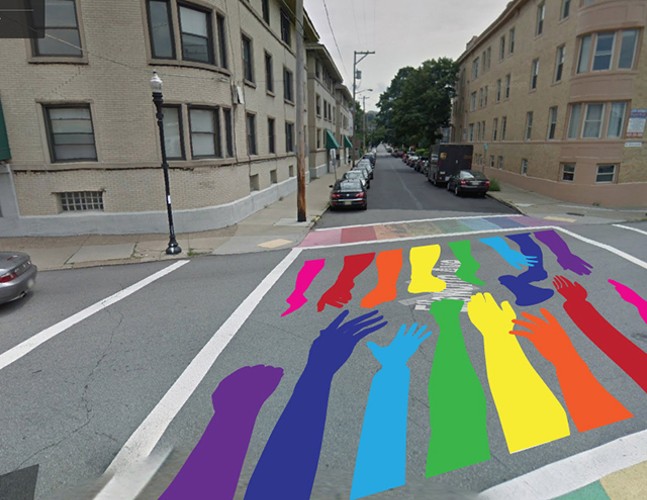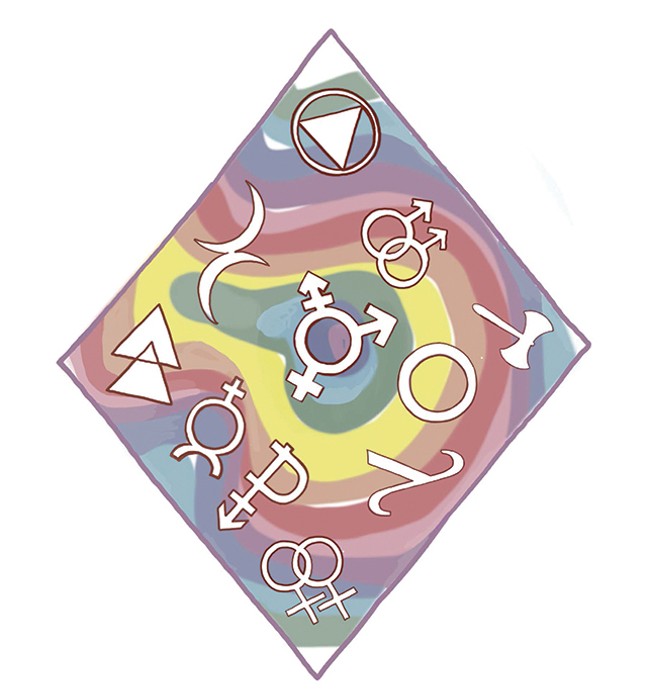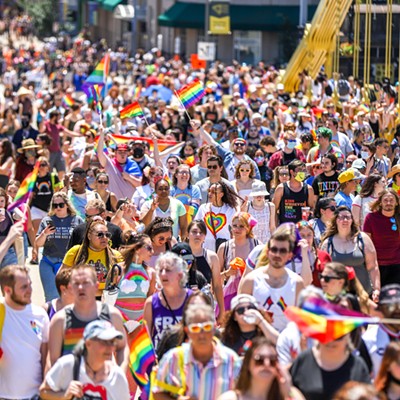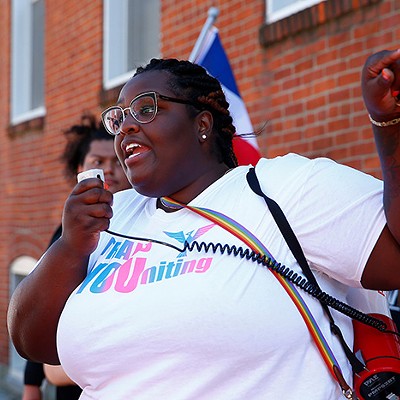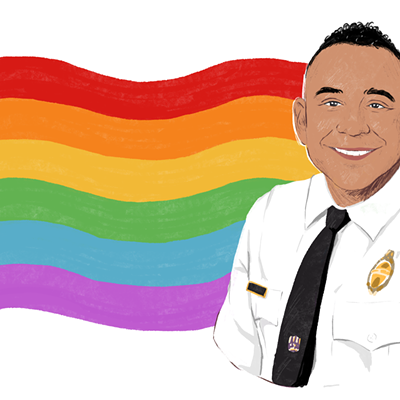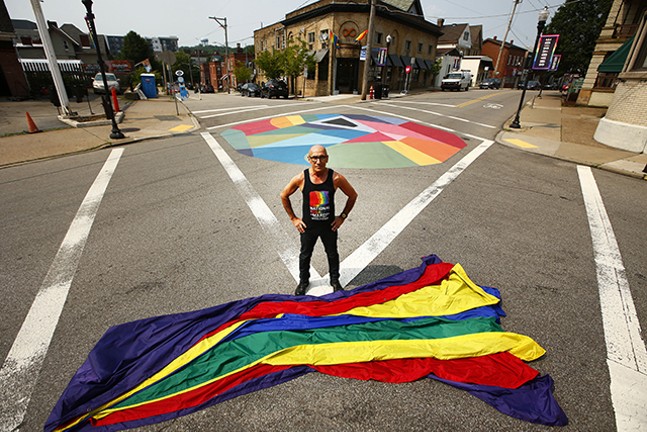
The corner of Ellsworth and Maryland Avenues has more significance than meets the eye.
In the mid-1990s, when LGBTQ Pride marches in Pittsburgh were small and grassroots, Richard Parsakian and others in the community held a homemade rainbow flag over that intersection.
Most of the early Pride marchers in Pittsburgh passed through the Ellsworth corridor, and the area was, and still is to some extent, home to a cluster of LGBTQ-owned businesses, like Parsakian’s Eons Fashion Antique and the bar 5801, as well as other LGBTQ-friendly places like Harris Grill. In 2015, after the U.S. Supreme Court ruled that all states must accept same-sex marriage licenses, people flooded into the intersection at Ellsworth and Maryland to celebrate.
Parsakian says the intersection has become like a Freedom Corner for Pittsburgh’s LGBTQ community, referencing the Hill District location that was seminal in Pittsburgh’s fight for civil rights.
“I hoisted the flags over the marchers at that intersection. This is sort of like our gayborhood,” says Parsakian.
And now the corner has been memorialized with a recently installed public art project to mark its significance. The intersection is filled with a collage of colors and shapes to represent every group of the LGBTQ community and to signify to visitors and Pittsburghers alike the role the area played in the fight for equal rights.
“The public art, it is sort of a small thing, but it is the city recognizing that we are a big part of the Pittsburgh community,” says Parsakian. “In terms of public art, there is no other place in the city that acknowledges the history and struggle of our community.”
It all started with a bit of guerrilla art in 2017. That year, two crosswalks at Ellsworth and Maryland were painted with rainbow stripes in honor of Pride. But, according to Pittsburgh City Councilor Erika Strassburger, that paint wasn’t approved by anyone in city government.
Even so, the community seemed to embrace it, and the rainbow crosswalks were allowed to stay. Two years later, the paint started to fade, and the Ellsworth corridor community, along with Strassburger, thought it was a good idea to do something more permanent to honor the LGBTQ community.
Working with the city’s Public Art Commission, a request for proposals was put out to find an artist. Leonardo Moleiro, a Venezuelan artist who now lives in Los Angeles, was chosen. He created an installation in his classic cubism style to honor the LGBTQ community and commemorate the 1969 Stonewall protests, a series of demonstrations in New York City that are widely considered some of the most important events in the modern LGBTQ rights movement.
The result of the public art project is a circular shape that sits in the center of the intersection. That circle is comprised of about two dozen shapes of different colors. The colors pay homage not just to the rainbow flag, but also the transgender flag, and include a nod to people of color within the LGBTQ community, says Moleiro. He says the circle design inside the square was “important to the energy flow” and acts as a way to have the design stand out and draw eyes to the prideful colors.
“I want to show harmony and balance,” says Moleiro. “With the LGBTQ community, we have to work together to achieve rights for everybody.”
But some Pittsburgh artists are perturbed that an LGBTQ artist wasn’t selected for the installation. Julie Mallis and Ginger Brooks Takahashi, both LGBTQ artists, submitted proposals to the city’s Request For Proposal (RFP) process. Mallis says the art commission missed an opportunity.
“Let’s not forget the intention of the mural is to acknowledge and celebrate 50 years since the Stonewall Riots,” says Mallis. “The least we can do is make sure the money set forth from District 8 is going back to someone in the LGBTQIA+ community when our rights are constantly attacked and our access to housing, jobs, and healthcare is restricted.”
The RFP was publicized in a TribLive article on March 6 and shared on many official Pittsburgh social media accounts, including Pittsburgh City Council District 8, Mayor Bill Peduto, and Peduto’s chief of staff Dan Gilman. Artists looking to submit proposals had four weeks to do so, from March 4 through March 29.
Daniel Tobin of the city’s Office of Management and Budget says “all proposals are reviewed and scored by committee based on the criteria that is listed in the specific solicitation.” The committee was made up of representatives from various Pittsburgh city departments and from Strassburger’s office. Pittsburgh City Paper asked who specifically submitted bids for the installation process, but Tobin said that information could only be revealed through a Right-To-Know request.
Strassburger says it would have been ideal for the installation to be completed by a local LGBTQ artist, but there were many limitations that made that harder to achieve, noting the timing of the project to be completed in time for Pride.
“They had to get the timing done quickly, and there were a lot of technical requirements for artists, and the expertise of the artists weighed heavily,” says Strassburger. “They had to have the expertise to paint it in a quick time, and experience with the type of paint used.”
Strassburger says she is glad the public art marks the area’s importance to Pittsburgh’s LGBTQ community. Eventually, she says a small plaque will also explain to passersby the significance of the art and the neighborhood.
But, she says, it serves many functions. The art also acts as a traffic-calming device, so drivers slow down when they are passing through the corridor. Strassburger hopes the installation will also serve as a place-making attraction for the business district, one that will send a welcoming message.
“You look back 20 years ago in Pittsburgh, and Walnut and Ellsworth were some of the few night time economies in the city,” says Strassburger. “Now there is a lot more competition. There is Butler Street and there is the North Shore. Shadyside needs to step up its game.”
To Parsakian, this public art recognition means a lot. He is 70 years old and says he has “gone through a lot” in terms of Pittburgh’s changing attitudes and policies toward LGBTQ people. He is very happy this will be a permanent marker on Ellsworth.
On June 28, the 50th anniversary of the Stonewall Riots, an unveiling event will be held at the intersection of Ellsworth and Maryland. Parsakian says it will include a DJ and a drag queen performance. The public art will also be covered with one of the flags that used to hang over the intersection during the early Pittsburgh Pride marches.
Parsakian feels fortunate that Pittsburgh city government has been so supportive of LGBTQ rights, even as many other municipalities in Pennsylvania lack LGBTQ non-discrimination protections based on sexual orientation and gender identity.
Parsakian hopes the event will act as a reminder of how far the community has come and he hopes the permanent public art will be an inspiration on how far the LGBTQ community still has to go to secure equal rights.
“The flag will return after 25 years,” says Parsakian. “A lot of people might not know who we lost over the years. It was gay men, it was lesbians, it was trans people of color, it was all of us, it wasn’t just one group. It is very important to hear that history.”

